Eclipse Mirage - OPOD
Eclipse Mirage - An Optical Phenomenon
Have you ever witnessed an eclipse with a difference? A stunning image captured by Jeremy Kirkendall during the partial solar eclipse on November 3rd, 2013, showcases a unique atmospheric optics phenomenon known as an eclipse mirage. The image, taken at Point Lookout State Park in Maryland, reveals two bright areas at the false horizon that are actually part of an inverted miraged image. But what exactly causes this mesmerizing spectacle?
The Mirage 'Vanishing Line'
As you examine Kirkendall's image, you may notice a line of clouds that appear to be mirroring each other above the sea. This mirage effect is due to the presence of a "vanishing line" in the mirage. The choppy upper level of the sea that seems to be the horizon is, in fact, the lower edge of the mirage. This optical illusion occurs when light rays passing from the upper cooler air across temperature gradients into the lower warm air are refracted towards the cool layer.
The Role of Temperature Gradients
The formation of an eclipse mirage relies on a layer of warm air beneath cooler air. In the case of Kirkendall's image, it is likely that the air had been warmed overnight through contact with the relatively warmer ocean. When light rays pass through these temperature gradients, they undergo refraction and are bent towards the cooler layer. In some instances, the refraction is strong enough to deflect the rays upwards, creating the illusion that they are coming from a reflected object below the real one.
Inverted Images and Omega Shapes
One fascinating aspect of eclipse mirages is the way they transform the appearance of celestial bodies. Michael Myers captured an equivalent miraged uneclipsed sun and its time sequence, revealing an omega or "Etruscan vase" shape. The lower image in Myers' sequence shows an inverted sun, further emphasizing the distortion caused by the mirage. Similarly, Kirkendall's enlarged picture of the eclipse mirage displays the moon's shadowed area inverted near the sea.
Multiple Routes and the Mirage 'Vanishing Line'
To understand the mechanics behind an eclipse mirage, let's examine a cloud in Kirkendall's image. Rays of light leaving the cloud can reach the observer's eye through two different routes. The lower rays, which are strongly refracted, contribute to the formation of an inverted image. This phenomenon occurs at multiple points along the cloud, creating a series of inverted images. However, there are positions where only one ray reaches the observer's eye, and rays from lower down cannot reach the eye at all. This particular position is known as the mirage 'vanishing line' and marks the point where the mirage effect appears to vanish.
A Stunning Sunrise Eclipse Mirage
Another remarkable example of an eclipse mirage was captured by Michael Gill during a sunrise eclipse in Kourou, French Guiana on September 22nd, 2006. Gill's image provides visible proof that the lower sun image is indeed inverted, reinforcing the consistent characteristics of this atmospheric optics phenomenon.
In conclusion, an eclipse mirage is a captivating optical phenomenon that occurs when temperature gradients cause light rays to refract and create inverted images of celestial bodies. These mirages can transform the appearance of the sun and moon, giving them unique shapes and orientations. The presence of a mirage 'vanishing line' adds an extra layer of intrigue to these illusions. So, keep your eyes peeled during eclipses and marvel at the wonders of atmospheric optics!
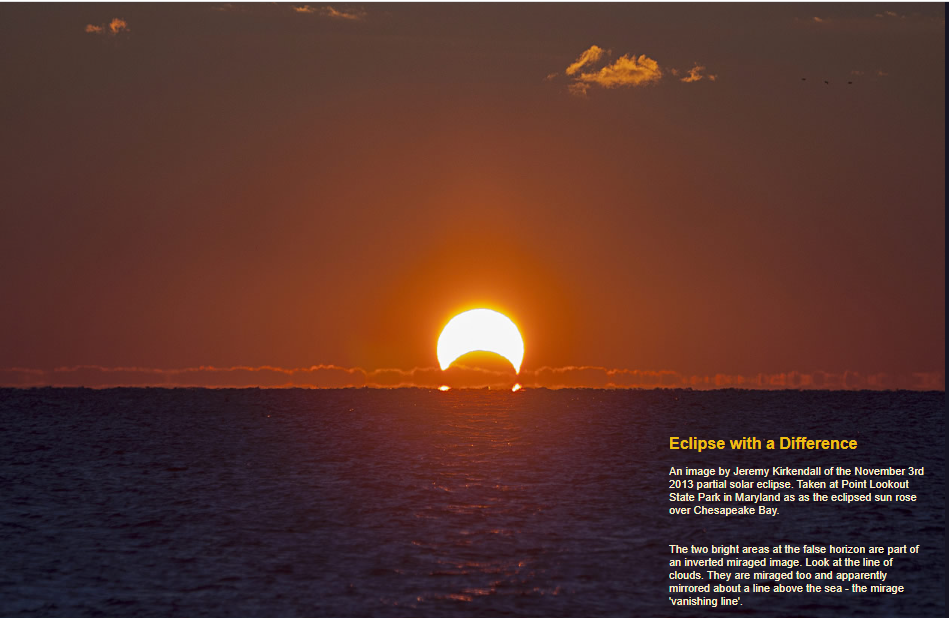
Eclipse with a Difference
An image by Jeremy Kirkendall of the November 3rd 2013 partial solar eclipse. Taken at Point Lookout State Park in Maryland as as the eclipsed sun rose over Chesapeake Bay.
The two bright areas at the false horizon are part of an inverted miraged image. Look at the line of clouds. They are miraged too and apparently mirrored about a line above the sea - the mirage 'vanishing line'.
The choppy upper level of the sea is not the horizon, it is the lower edge of the mirage.
©Jeremy Kirkenall, shown with permission
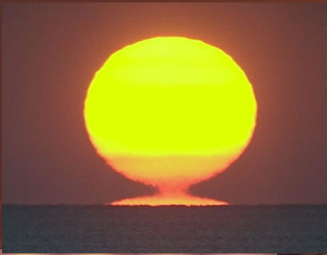
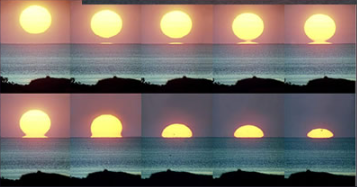
Left: An equivalent miraged uneclipsed sun and its time sequence (a sunset) captured a few years ago by Michael Myers.
The sun takes on an omega or 'Etruscan vase' shape. The lower image is an inverted sun.
Right: The enlarged picture by Jeremy Kirkendall shows the moon shadowed area inverted close to the sea.
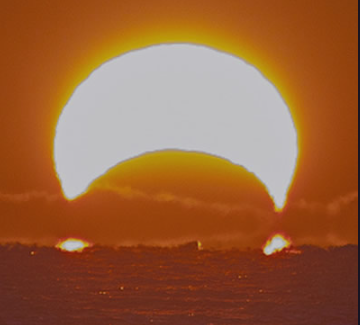
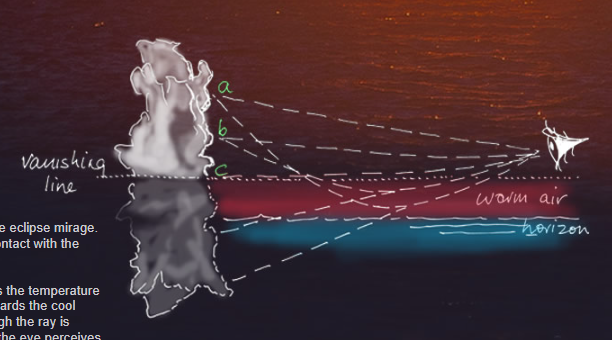
A layer of warm air beneath cooler air produced the eclipse mirage. Probably the air had been warmed overnight by contact with the relatively warmer ocean.
Light rays passing from the upper cooler air across the temperature gradients into the lower warm air are refracted towards the cool layer. In cases where the refraction is strong enough the ray is deflected so that it travels upwards - In that event the eye perceives the upward going ray as coming from a reflected object (the sun or a distant cloud) beneath the real one.
At right, rays leaving a cloud at point (a) can reach the eye via two routes. The lower strongly refracted rays helps form an inverted image. Point (b) behaves the same. Only one ray reaches the eye from point (c) and rays from lower down cannot reach the eye at all. Point (c) marks the position of the mirage 'vanishing line'. The vanishing line bisects the clouds in the eclipse picture at top.
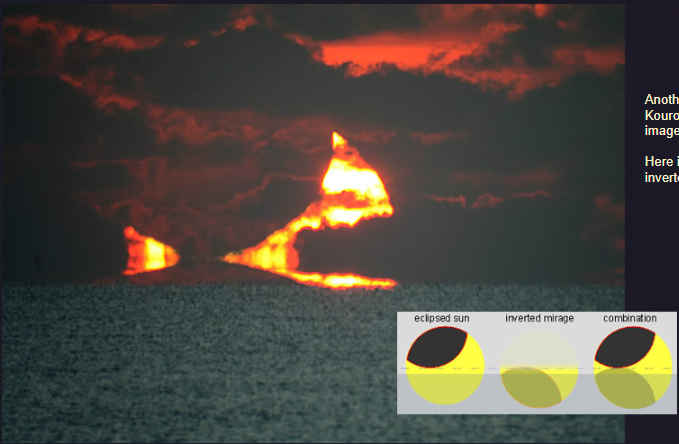
Another eclipse mirage, this time sunrise at Kourou, French Guiana 22nd September 2006 imaged by Michael Gill.
Here is visible proof that the lower sun image is inverted.
Note: this article has been automatically converted from the old site and may not appear as intended. You can find the original article here.
Reference Atmospheric Optics
If you use any of the definitions, information, or data presented on Atmospheric Optics, please copy the link or reference below to properly credit us as the reference source. Thank you!
-
<a href="https://atoptics.co.uk/blog/eclipse-mirage-opod/">Eclipse Mirage - OPOD</a>
-
"Eclipse Mirage - OPOD". Atmospheric Optics. Accessed on April 19, 2024. https://atoptics.co.uk/blog/eclipse-mirage-opod/.
-
"Eclipse Mirage - OPOD". Atmospheric Optics, https://atoptics.co.uk/blog/eclipse-mirage-opod/. Accessed 19 April, 2024
-
Eclipse Mirage - OPOD. Atmospheric Optics. Retrieved from https://atoptics.co.uk/blog/eclipse-mirage-opod/.